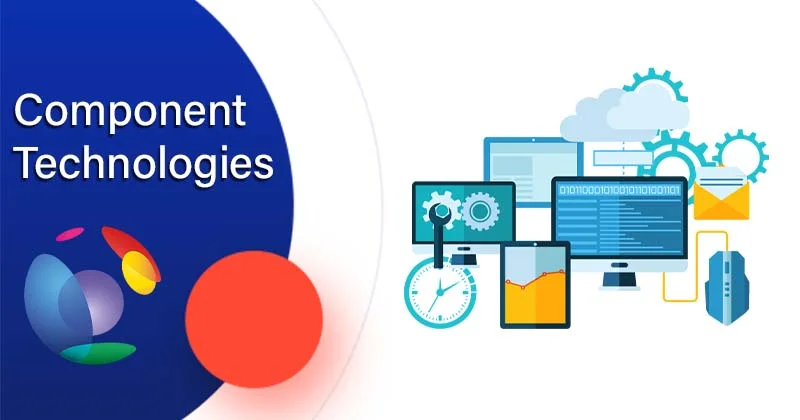In the continuous evolving landscape of software development, the concept of Component Technologies has become a pivotal force. This paradigm empowers developers to craft in-detail applications by dissecting them into manageable, reusable components. These components, which encapsulate discrete functionalities, are the building blocks that enable the creation of sophisticated software systems.
They are developed and tested independently and then seamlessly integrated to form a cohesive whole, simplifying programming tasks, enhancing software quality and offering an array of benefits.
Let’s get into the intricacies of Component Technologies, exploring the various types, advantages, disadvantages and best practices that govern this transformative approach to software development.
What are Components?
The very essence of Component Technologies lies in understanding what components are. Components, in the context of software, are self-contained, pluggable abstract data units. They are business objects with predefined & reusable behaviors.
The implementation details are obscured, residing within the component, encapsulated behind well-defined interfaces. These interfaces serve as the entry points to a component’s functionality, fostering accessibility through standardization. In this approach, providers and clients communicate through these interfaces, akin to intermediaries facilitating collaboration.
A key feature of component-based systems is that they manage a single instance of a component per system, even when multiple clients are harnessing the component’s functionality. Object references, which are integral components of objects implementing an interface, play a vital role in connecting clients with the component.
What is The Main Component of Technology?
Component Technologies have revolutionized software development by transforming monolithic applications into modular systems. They enable developers to assemble applications by combining pre-built, specialized components or modules. These modules serve distinct purposes and can be reused across various applications. Standardized interfaces provide a smooth pathway to integrate components into a system, resulting in rapid and efficient development.
The roots of Component Technologies can be traced back to Object-Oriented Programming (OOP), which emphasized the creation of reusable software modules. This paradigm shift, sparked in the early 2000s, has changed the way developers approach software development.
Types of Libraries in Component Technologies
The cornerstone of Component Technologies lies in the diverse types of libraries available. These libraries, comprising programming languages, frameworks and tools, provide the building blocks essential for creating complex applications.
Here’s a glimpse of the different library types:
1. Class Libraries
Class libraries consist of collections of reusable code that developers can leverage to construct software applications. These libraries offer pre-written code segments for handling user input, data processing and report generation. They transcend programming languages, making them a favorite among developers.
2. Framework Libraries
Framework libraries extend the concept of class libraries. They offer a complete architecture for software application development. These frameworks encapsulate pre-written code along with protocols for organizing it into a functional software application.
Commonly used in web development, framework libraries provide rules for building scalable and maintainable web applications.
3. Component Libraries
Component libraries are the epitome of reusability. They comprise pre-built modules, including user interface controls, communication elements and data processing units. The primary objective of component libraries is to streamline the development process by offering ready-made code for constructing complex applications efficiently.
Types of Components in Component Technologies
To understand Component Technologies comprehensively, it’s essential to explore the various component types, their roles and real-world examples.
1. Application Programming Interfaces (APIs)
APIs facilitate software development by exposing code to external parties. They enable software systems to communicate and collaborate seamlessly, without necessitating an in-depth understanding of the underlying source code.
Well-known example of APIs include Google Maps APIs.
2. Object-Oriented Programming (OOP)
Object-Oriented Programming (OOP) is a widely embraced programming paradigm. It empowers developers to construct software using objects that encapsulate both data and behavior. These objects interact to produce outcomes, simplifying software modification and maintenance. OOP is exemplified in programming languages like Java, C++ and Python.
3. Component Object Model (COM)
COM, developed by Microsoft, enables communication between software components in Windows operating systems. It fosters the creation of reusable components that transcend software boundaries. A significant feature is its compatibility with multiple programming languages.
Notable examples of software systems employing COM include Microsoft Office & Internet Explorer.
4. Service-Oriented Architecture (SOA)
SOA revolutionizes software interaction through web services. It involves breaking down software components into functional units, exposing them as web services. This approach enables interoperability between diverse software systems, facilitating independent modification and enhancement of each system.
Prominent web services include Amazon Web Services.
5. Microservices
Microservices introduce a novel architectural approach, segmenting software systems into small, independent components that collaborate harmoniously. This architecture enhances flexibility, scalability and modularity while ensuring fault tolerance and high availability.
Pioneers of microservices include companies like Netflix & Uber.
Best Practices for Developing Component-Based Systems
The widespread adoption of component-based systems has necessitated the establishment of best practices to navigate the challenges and maximize the benefits:
Design Principles for Component-Based Systems
- Develop independent, reusable and replaceable components.
- Employ popular interfaces and contracts to ensure compatibility.
- Strike the right balance of abstraction to hide complexity from the system.
Development Strategies for Component-Based Systems
- Utilize a component model, such as OSGi or COM for managing component lifecycles.
- Develop and test components in isolation before integration.
- Implement dependency injection to manage component dependencies and enhance flexibility.
Testing and Maintenance of Component-Based Systems
- Harness automated testing to verify component functionality.
- Employ monitoring tools to detect errors and performance issues.
- Plan for updates of components to ensure long life maintainability.
Common Challenges and Solutions
Implementing Component Technologies is not without its challenges but with a strategic approach, these challenges can be addressed effectively:
Issues with Component Integration
- Compatibility issues may arise when integrating components.
- Conflicts emerge when multiple components are dependent on the same resources.
Complexity in Component-Based Systems
- As the number of components grows, system complexity increases.
- Managing dependencies between components becomes challenging.
Approaches to Addressing Common Challenges
- Standardize component models to ensure compatibility.
- Embrace dependency injection for efficient management of component dependencies.
- Adopt a modular architecture to reduce complexity and enhance maintainability.
Advantages of Using Component Technologies
The adoption of Component Technologies in software development offers a plethora of advantages:
- Time Savings: Components accelerate development by eliminating the need to start from scratch for every project, shortening the development timeline.
- Reusability: Code reuse minimizes duplication, maintains consistency and enhances efficiency & maintainability.
- Flexibility: Component-based applications conform to changing business needs, allowing for modifications without impacting the entire application.
- Better Collaboration: Developers can collaborate efficiently, creating complex applications in a coordinated manner.
- Scalability: Components enable applications to be easily scaled up or down to meet changing requirements.
Disadvantages of Component Technologies
As with any technological innovation, Component Technologies come with their share of disadvantages:
- High Cost: Pre-built components often come with a price tag, including licensing fees, which can strain budgets.
- Complexity: Managing the updates and compatibility of multiple pre-built components can be difficult.
- Performance: The generic and flexible nature of pre-built components can sometimes lead to an increase in an application’s size, potentially affecting performance, particularly in the context of mobile applications.
- Security: Utilizing pre-built components carries the risk of hidden vulnerabilities or backdoors that could be exploited by malicious actors. Ensuring the security of such components, especially when they come from diverse vendors, can be a time-consuming process.
- Dependency: Companies using pre-built components may find themselves locked into the vendor’s ecosystem, making it challenging to switch to an alternative vendor. The lack of easy replacement options can restrict flexibility.
Future Trends and Innovations in Component Technologies
Component Technologies continue to evolve and emerging trends and innovations are shaping their future:
- Microservices Architecture: The microservices architectural style is gaining momentum, emphasizing the use of small, independent components to construct large, scalable systems.
- Serverless Computing: Serverless computing enables developers to write and deploy code without the burden of managing underlying infrastructure, offering flexibility and cost efficiency.
- Enhanced Compatibility and Interoperability: Ongoing efforts to improve compatibility and interoperability will make it easier to integrate diverse components seamlessly.
- New Component Models and Programming Paradigms: The development of innovative component models and programming paradigms will offer developers new tools and methods for creating software.
- Artificial Intelligence and Machine Learning Integration: AI and machine learning will play an increasingly significant role in automating component creation and integration.
Final Thought
Component Technologies have introduced a powerful approach to building software systems that are modular, scalable and maintainable. By leveraging the benefits they offer, developers can simplify testing, debugging and maintenance processes.
However, it’s crucial for organizations to carefully consider the pros and cons of various component technologies, choose the most suitable ones for their projects & adhere to best practices for the development and integration of components.
As the realm of software development continues to advance, Component Technologies will remain at the forefront of innovation. Staying informed about emerging trends and innovations will empower developers to stay ahead of the curve and continue crafting efficient and effective software systems.
In a digital world where complexity is the norm, Component Technologies provide a roadmap to streamlined, effective software development and their impact is poised to grow in the coming years.



